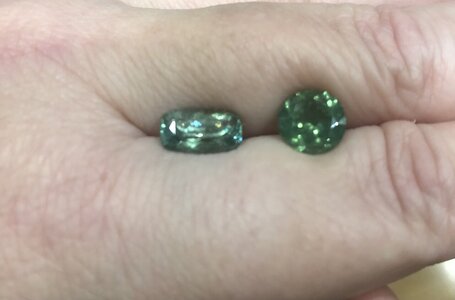Double E
Brilliant_Rock
- Joined
- Jun 23, 2018
- Messages
- 957
Well cut clean hue chryso can be quite sparkly. But dispersion May be something chryso is lacking compared to the other two.
However, how obvious is that “fire” on demantoid and green zircon irl? I have an impression that green zircon, especially more vivid and darker ones shows however less fire when compared to say blue zircon. And as demantoid has higher dispersion (I hope I am right here, otherwise just correct me), should it be more firey than green zircon?
The lighter toned color on green Zircon if it is well cut can show a lot of dispersion, plus the lighter greens can be medium Zircon, even high in some cases.
The Sri Lanka green zircon I have is light to medium in tone (it's got a blue-green hue), but is definitely high zircon. No eye visible inclusions - I will have to loupe it for when I take pics/vids for this thread. Definitely no haze, either.
Most of the clean looking green zircon I've seen is dark enough in tone that I don't expect they'd show much in the way of dispersion. They also seem to have an "oil in water" effect that I don't know the gemological term for (not double refraction; it's a different effect)
If it has highly visible double refraction, then yes, it is high Zircon, but medium Zircon has pronounced double refraction too.
Very rare (next to nonexistence) for a medium tone green to be high Zircon. If there is blue in it, then it has probably been heated to turn into a blue Zircon, but not all heat blue all the way, as matter of fact most have some green in them. But some have a lot of green.
Please do share.
I have a really beautiful green zircon from Sri Lanka. It's cut in a triangle shape. It sparkles fantastically. Demantoid has a higher amount of dispersion than zircon but it is classically an included stone. Russian demantoid especially is known for its inclusions. Namibian demantoid tends to be cleaner and lighter in tone - so higher visible dispersion. You can find clean demantoid from Namibia, but it has a lighter tone than the classic Russian stones - so it isn't as vivid; it's more of a yellow and/or brown tinged.
Clarity for clarity and tone for tone demantoid will be higher in fire than demantoid, because science.
I'm at work today, but later this weekend I'll try to get a photo and video of my pure green, clean zircon next to a Mali garnet I have that is extremely high in dispersion.
How about a vivid green zircon with a medium tone, eyeclean and without metamoct dimness? How should we rate such stone?
I am a bit confused for the criteria to determine whether a zircon is high or low or anywhere between the two…Is remaining double refractive a one of the key requirements? This seems what I got from our discussion so far.
